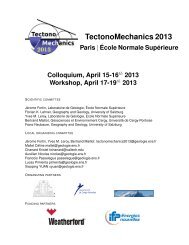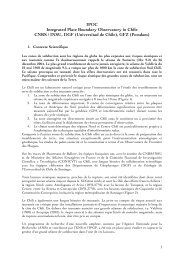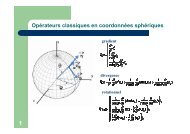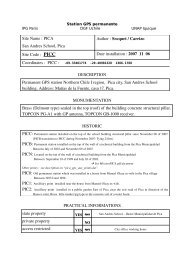PDF file - Laboratoire de Géologie de l'Ecole normale supérieure - Ens
PDF file - Laboratoire de Géologie de l'Ecole normale supérieure - Ens
PDF file - Laboratoire de Géologie de l'Ecole normale supérieure - Ens
You also want an ePaper? Increase the reach of your titles
YUMPU automatically turns print PDFs into web optimized ePapers that Google loves.
15<br />
SOCQUET ET AL.: GPS MEASUREMENTS TO REFINE INDIA/SUNDA RELATIVE MOTION<br />
each campaign, <strong>de</strong>pending on the quality of<br />
measurements, the quality and homogeneity in the<br />
type of antennae used, the mean length of baselines<br />
for the consi<strong>de</strong>red campaign (the dispersion increases<br />
with the length of the baselines essentially due to<br />
uncertainties in satellites orbits) and the number of<br />
stations processed simultaneously. Values range<br />
between 1 and 4 mm for the north component and<br />
between 3 and 8 mm for the east component, whereby<br />
more recent data generally show better repeatabilities.<br />
The solution vectors and associated<br />
variance/covariance matrices of the in<strong>de</strong>pen<strong>de</strong>nt daily<br />
solutions have been combined by GLOBK, based on a<br />
Kalman filtering approach, to obtain a multi-session<br />
free-network solution for each campaign with loose<br />
constrains on positions and velocities. Long term<br />
repeatabilities (i.e. the scatter of in<strong>de</strong>pen<strong>de</strong>nt<br />
campaign <strong>de</strong>terminations about their <strong>de</strong>tren<strong>de</strong>d<br />
average) have been performed for this solution and<br />
average values are about1.8 mm for the north<br />
component and 2.9 mm for the east component for<br />
baselines of about 1000 km (Fig S1). Velocities are<br />
not estimated at this stage but rather after the<br />
combination with the GIPSY solution.<br />
1.2. Details on GIPSY processing<br />
The solution computed with the GIPSY-OASIS II<br />
v2.6.1 [Blewitt, et al., 1988] software uses a data set<br />
spanning 1994-2002. Again, GEODYSSEA (1994-<br />
1996-1998), THAICA (1994-1996-2000) and<br />
Sulawesi (1999-2002) campaigns have been reprocessed<br />
in<strong>de</strong>pen<strong>de</strong>ntly from the GAMIT solution.<br />
Theses are the data common to the GAMIT/GLOBK<br />
solution, and represent 60% of the sites used in the<br />
final combination. Three years of the permanent<br />
Malaysian (MASS) network (1999-2000-2001),<br />
Sulawesi (1996-1997-1998) and THAICA (2001) data<br />
have been ad<strong>de</strong>d. Also, up to 30 IGS stations world<br />
wi<strong>de</strong> spread have been inclu<strong>de</strong>d in the processing to<br />
allow an accurate mapping in the ITRF.<br />
The precise point positioning (PPP) strategy has<br />
been chosen, using fixed satellite orbits and clocks<br />
distributed by JPL (Jet Propulsion Laboratory). As in<br />
the GAMIT processing, the ionosphere-free linear<br />
combination of GPS phase and pseudorange data is<br />
used, here with a sample rate of 5 minutes and an<br />
elevation cut-off angle of 15 <strong>de</strong>grees. Tropospheric<br />
<strong>de</strong>lay parameters (zenith path <strong>de</strong>lay and gradients) are<br />
also estimated. Ocean loading parameters are inclu<strong>de</strong>d<br />
for each GPS location [Scherneck, 1991], and to<br />
account for the different GPS antennae, the NGS<br />
relative antenna phase centre corrections [Ma<strong>de</strong>r,<br />
1998] are applied.<br />
Each campaign solution is projected on ITRF-<br />
2000 using up to 25 IGS stations. Then, velocities<br />
are obtained by fitting a linear trend through<br />
station’s position by a mean square minimization.<br />
At that stage, no adjustments of the station positions<br />
are allowed. Outliers (positions differing by more<br />
than 2mm from their estimated value) are removed<br />
from the linear trend estimation. Those can be due<br />
to measurements errors of any kind or co-seismic<br />
induced displacements for example. A <strong>de</strong>tailed<br />
<strong>de</strong>scription on the GIPSY solution and discussion of<br />
its uncertainties are given in [Simons, et al.,<br />
submitted].<br />
1.3. Combination<br />
A combined solution was ma<strong>de</strong> from the<br />
GAMIT and GIPSY processing. It spans the entire<br />
region from India and Nepal up to the south-eastern<br />
tip of the Indonesian archipelago. This solution was<br />
generated by combining loosely constrained<br />
variance-covariance matrices from the two<br />
in<strong>de</strong>pen<strong>de</strong>nt solutions with the GLOBK Kalman<br />
filter. Common sites (the regional IGS stations we<br />
use and 60% of our campaign sites) enable a strong<br />
unification of the two solutions. The final mapping<br />
in the International Terrestrial Reference Frame<br />
(ITRF) 2000 is done by minimizing (in a mean<br />
square procedure) the <strong>de</strong>parture of a selected list of<br />
IGS stations positions and velocities from their a<br />
priori values in the ITRF2000 [Altamimi, et al.,<br />
2002]. On these stations, the velocity misfits range<br />
between 0 and 2 mm/yr, indicating an accurate<br />
mapping in the reference frame (Table S2). A<br />
comparison of velocities <strong>de</strong>termined in<strong>de</strong>pen<strong>de</strong>ntly<br />
(GAMIT/GLOBK vs. GIPSY) at common sites is<br />
also ma<strong>de</strong> (Table S3). They differ by no more than<br />
2 mm/yr at most sites, and these differences should<br />
probably be attributed to the usage of different<br />
orbits (IGS vs. JPL) and the slightly different<br />
antenna phase centre corrections (IGS vs. NGS) that<br />
were applied. Velocities in ITRF2000 of most sites<br />
involved in the combined solution with their 1-σ<br />
uncertainties are given in Table S4. The velocities<br />
are plotted with respect to the Sunda block on Fig. 2<br />
in the paper.






